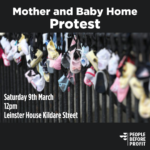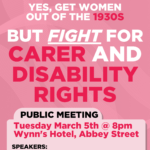There used to be a certain level of decency in Ireland. Even in its poorest decades, the state provided homes for its citizens and the sight of a homeless person was both rare and shocking. Today, homelessness and housing poverty are all around us. Fine Gael have been in office for eight years, but instead of meeting people’s fundamental need for a home, they have relied overwhelmingly on market forces. This turns houses into commodities rather than seeing them as essential services – a policy that suits the top 20% of Irish society.
One of Fine Gael’s key objectives was to reflate the property market so that banks, speculators, developers and landlords would increase their wealth. This has been incredibly successful, as the value of accumulated assets in the state has risen by €300 billion since 2012. The human costs have been tremendous however, with large sections of Irish society now living in housing poverty. Lets look at the winners and the losers of FG’s policy.

Winners
Vulture Funds – Fine Gael (FG) met with the private funds industry on 65 occasions between 2012 and 2014. They subsequently introduced special tax breaks for international investors and facilitated their purchase of between €200- €300 billion of distressed assets.
Landlords – By refusing to build adequate public and affordable housing, FG has facilitated a major spike in rents and house prices in the state. By co-incidence one in three TDs from Fine Gael and Fianna Fail are registered as landlords.
Banks – The state bailed out the Irish banks and failed to protect customers who were overcharged or had their loans transferred to vulture funds.
Developers – The National Assets Management Agency (NAMA) took over loans from the top developers in the state, hired many of them to work for a salary of €100,000 a year and often gave them credit to continue their projects.
Losers
Homeless People – The high cost of renting coupled with a sever lack of public housing has left more than 10,000 people homeless – 3,600 of them children.
Renters – Rents are now at an all-time high. The average cost of renting in Ireland is now €1,304 a month, making it 75% more expensive than the bottom of the market and 26% higher than the previous peak during the Celtic Tiger.
People on Housing Lists – There are roughly 87,000 people languishing on social housing waiting lists despite there being zoned land to accommodate more than 100,000 houses.
Mortgage Holders – Irish mortgage holders are forced to pay the highest rate in the European Union. Figures from the Irish Central Bank reveal that banks here charge on average 3.2% compared with 1.8% on the continent working out at an extra €65,000 on a €300,000 mortgage over a 25 year term.
People in Mortgage Arrears – Irish people paid over the odds for property during the bubble and faced higher than average mortgage rates on their loans. This coupled with the unemployment crisis has left 72,000 families in mortgage arrears.












